| |
14:15
|
0167.
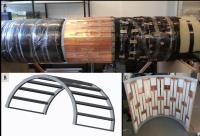 |
A 32-channel integrated body coil for 7 Tesla whole-body imaging 
Stephan Orzada1, Andreas K. Bitz2,
Oliver Kraff1, Mark Oehmigen1,3,
Marcel Gratz1,3, Sören Johst1,
Maximilian N. Völker1, Stefan H. G. Rietsch1,3,
Martina Flöser2, Thomas Fiedler2,
Samaneh Shooshtary4, Klaus Solbach4,
Harald H. Quick1,3, and Mark E. Ladd1,2
1Erwin L. Hahn Institute for MRI, Essen, Germany, 2Medical
Physics in Radiology, German Cancer Research Center (DKFZ),
Heidelberg, Germany, 3High
Field and Hybrid MR Imaging, University Hospital Essen,
Essen, Germany, 4High
Frequency Technology, University of Duisburg-Essen,
Duisburg, Germany
Due to the severe problems with B1 inhomogeneity, volume
resonators are not a good choice for body applications at
ultra-high fields, and local multi-channel arrays are
commonly used for transmission. In this work we present an
integrated 32ch transmit/receive body array for 7 Tesla
whole-body imaging. First in vivo images show a human
volunteer imaged completely in 4 stations.
|
| |
14:27
 |
0168.
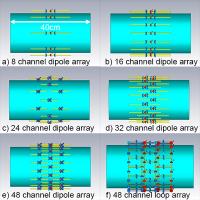 |
Approaching the Ultimate Intrinsic SNR with Dense Arrays of
Electric Dipole Antennas 
Gang Chen1,2,3, Riccardo Lattanzi1,2,
Daniel Sodickson1,2, and Graham Wiggins1,2
1The Center for Advanced Imaging Innovation and
Research (CAI2R), Department of Radiology, New York
University School of Medicine, New York, NY, United States, 2The
Bernard and Irene Schwartz Center for Biomedical Imaging,
Department of Radiology, New York University School of
Medicine, New York, NY, United States, 3The
Sackler Institute of Graduate Biomedical Science, New York
University School of Medicine, New York, NY, United States
Coil designs motivated by the ideal current patterns
corresponding to the Ultimate Intrinsic SNR (UISNR) have
been used to boost central SNR at 3T and 7T. For a
cylindrical phantom and a current distribution defined on a
concentric cylindrical surface, the ideal current pattern
for optimal central SNR includes both divergence-free and
curl-free components. While loops are exclusively
divergence-free, recent work has shown that electric dipole
antennae include both divergence-free and curl-free current
components. Here we explore in simulation whether arrays
with an increasing number of electric dipole antennas can
approach UISNR in the center of a head-sized phantom at 7T,
and investigate selected practical design considerations.
|
| |
14:39
|
0169.
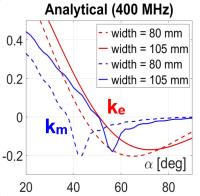 |
Optimization of the Transceiver Phased Array for Human Brain
Imaging at 9.4 T: Loop Overlapping Rediscovered. 
Nikolai I Avdievich1, Ioannis Giapitzakis1,
Andreas Pfrommer1, and Anke Henning1,2
1High-field Magnetic Resonance, Max Planck
Institute for Biological Cybernetics, Tübingen, Germany, 2Institute
for Biomedical Engineering, University and ETH Zurich,
Zurich, Switzerland
Ultra-high field (UHF) (>7T)
transmit (Tx) and transceiver surface loop phased arrays
improve Tx-efficiency and homogeneity for human brain
imaging. Overlapping the loops enhances Tx-efficiency and
SNR by increasing the penetration depth. However,
overlapping can compromise decoupling and SNR by generating
a substantial mutual resistance. Therefore, UHF Tx-arrays
are commonly constructed using gapped loops. Based on
analytical optimization we constructed a 9.4T 8-loop head
transceiver array. Both the magnetic and electric coupling
were compensated at the same time by overlapping and
excellent decoupling was obtained. Tx- and Rx-performance of
the array was compared favorably to that of a gaped array.
|
| |
14:51
|
0170.
 |
Comparison of 3T whole body parallel transmit arrays based on
measured data from full scale models 
Eddy B Boskamp1, Saikat Saha1, Ricardo
Becerra1, and Michael Edwards1
1Engineering, GE Healthcare, Waukesha, WI, United
States
In this study we are comparing 16 channel TEM, 8 channel TEM
and 8 loop array pTx body coils based on experimental data
obtained from full scale whole body prototypes as opposed to
only simulation. Besides SAR, efficiency and uniformity,
there are additional criteria to include when selecting a
body coil for parallel transmit. Examples are star intensity
artifact, E fields that heat up cables and baluns, VSWR, and
perturbation sensitivity, which may make it impossible to
build a certain design given obtainable tolerances.
|
| |
15:03
|
0171.
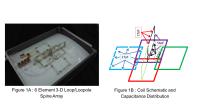 |
A 3D Loop-Loopole Receive Array for Spine Imaging at 3.0 T. 
Karthik Lakshmanan1,2, Ryan Brown1,2,
and Graham C Wiggins1,2
1Center for Biomedical Imaging, Department of
Radiology, NYU School of Medicine, Newyork, NY, United
States, 2Center
for Advanced Imaging Innovation and Research (CAI2R), NYU
School of Medicine, Newyork, NY, United States
High channel count RF receive coil arrays have become
commonplace due to the advent of parallel imaging techniques
and due to technical advances in receive chain technology.
Using these general purpose coil arrays SNR can be maximized
over wide depths by covering the imaging region with an
array of planar loops. This is usually achieved by reducing
the coil dimensions while still maintaining sufficiently
high unloaded-to-loaded Q ratio. In this work we aim to
improve upon the SNR of a high element count array by adding
concentric orthogonal "Loopole" elements. The asymmetric
behavior of the loopoles combined with its orthogonal
location provided SNR improvements both at shallow and deep
regions in an imaging plane.
|
| |
15:15
|
0172.
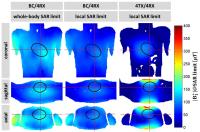 |
Detailing Local Multi-Channel RF Surface Coil versus Body RF
Coil Transmission for Cardiac MRI at 3 Tesla: Which
Configuration is Winning the Game? 
Oliver Weinberger1,2, Lukas Winter1,
Matthias A Dieringer1, Antje Els1,
Celal Oezerdem1, Antonino Cassara3,
Harald Pfeiffer3, and Thoralf Niendorf1,2
1Berlin Ultrahigh Field Facility (BUFF), Max
Delbrueck Center for Molecular Medicine (MDC), Berlin,
Germany, 2Experimental
and Clinical Research Center (ECRC), Charité Medical
Faculty, Berlin, Germany,3Physikalisch Technische
Bundesanstalt (PTB), Berlin, Germany
In this work a local four-channel transmit/receive RF coil
dedicated for cardiac MR at 3T is compared to a conventional
built-in body RF coil in conjunction with a four-channel
receive-only RF coil. SAR and B1+simulations
of both configurations are shown. The invivo efficiency
performance of both coils in respect to B1+/sqrt(SAR)
is demonstrated in 12 healthy subjects. The efficiency
surplus of the local RF coil was used to increase the
applicable flip angle FASSFP of
a standard high resolution 2D SSFP protocol or to shorten
the used repetition time TRSSFP by
54%.
|
| |
15:27
|
0173.
 |
Design of a 8-channel transceive dipole array with up to 64
receive-only loop coils 
Ingmar Voogt1, Dennis W.J. Klomp1,
Hans Hoogduin1, Peter R. Luijten1,
Cornelis A.T. van den Berg1, and Alexander J.E.
Raaijmakers1
1UMC Utrecht, Utrecht, Netherlands
We have developed an array combination consisting of eight
fractionated dipole antennas combined with 64 receive loops.
Loops are combined in 16 linear groups of four. Eight are
equipped with a transmit dipole antenna, eight are not. The
coupling between all elements is below -15 dB. The transmit
efficiency is not influenced by the presence of the receive
loops. Phantom MRI measurements show strong enhancement of
the SNR. Finally, preliminary human scans (T2w images) have
been acquired.
|
| |
15:39
 |
0174.
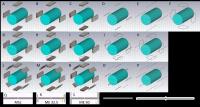 |
Parallel Transmit (pTx) Capability of Various RF Transmit
Elements and Arrays at 7T UHF MRI 
Stefan HG Rietsch1,2, Stephan Orzada1,
and Harald H Quick1,2
1Erwin L. Hahn Institute for MR Imaging,
University of Duisburg-Essen, Essen, Germany, 2High
Field and Hybrid MR Imaging, University Hospital Essen,
Essen, Germany
First steps towards whole body imaging with remote arrays at
7T UHF MRI are currently undertaken. Parallel transmit (pTx)
capabilities of transmit arrays can be evaluated by the
number of degrees of freedom which characterize the shim
capabilities. In this work, 16 different pTx arrays with
different transmit elements and combinations of transmit
elements are simulated to examine inter element coupling
behavior, singular values to determine the degrees of
freedom and shim capabilities. Combining dipoles and loops
seems to be the most promising approach among the
investigated pTx arrays.
|
| |
15:51
|
0175.
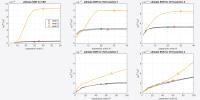 |
About the Ultimate SNR for Cylindrical and Spherical RF Arrays
in a Realistic Human Head Model 
Andreas Pfrommer1 and
Anke Henning1,2
1Max Planck Institute for Biological Cybernetics,
Tuebingen, Germany, 2Institute
for Biomedical Engineering, UZH and ETH Zurich, Zurich,
Switzerland
In this work we investigated differences in the ultimate SNR
in a realistic human head model for two configurations with
the RF array elements distributed on either a cylindrical or
a spherical holder. The basis set of solutions in our
approach was created by vector cylindrical and spherical
harmonics, which are known to form a complete set of
eigenfunctions to Maxwell’s equations in free-space.
Assuming both surfaces have the same radius, the spherical
geometry yielded higher SNR in grey and white matter
compared to the cylindrical one. Moreover it allowed higher
acceleration factors with the same g-factors.
|
| |
16:03
|
0176.
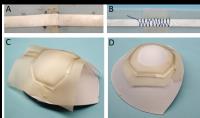 |
High-quality flexible printed MRI receive coils towards garment
integration 
Pierre Balthazar Lechene1, Joe Corea1,
Anita Flynn1, Michael Lustig1, and Ana
Arias1
1EECS, UC Berkeley, Berkeley, CA, United States
Close proximity of MRI receive coils to the patient can
allow an increase of signal-to-noise ratio (SNR).
Integrating the coils into garments that tightly conform to
the body can provide such proximity. This work develops
flexible printed MRI coils on a mesh with the potential to
be integrated into garments. The dielectric used in the
coil’s capacitors is optimized to provide SNR within 91% of
conventional coils. Encapsulation enhances the coils
mechanical robustness, allowing bending below 1mm of radius
of curvature. It is shown that, by cutting and sewing, the
coils can be tailored to intimately fit a brassiere cup.
|
|












